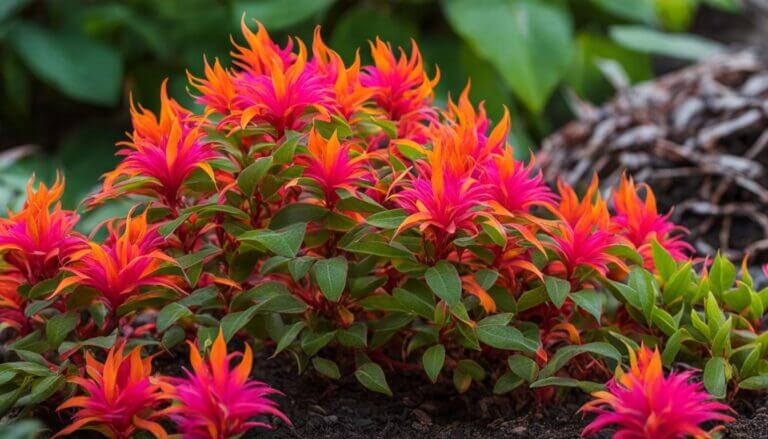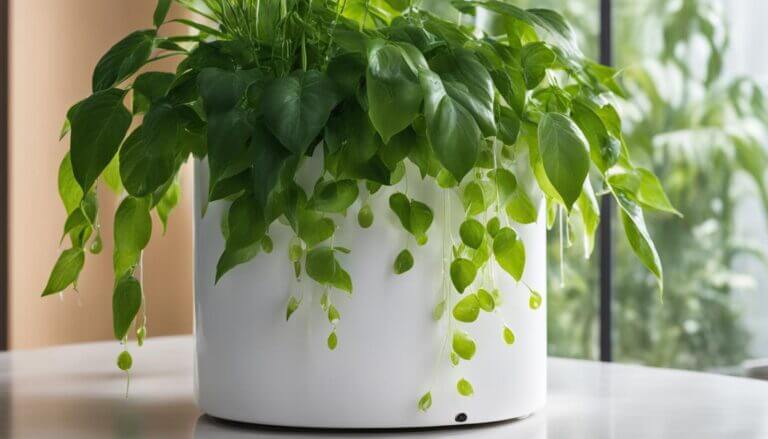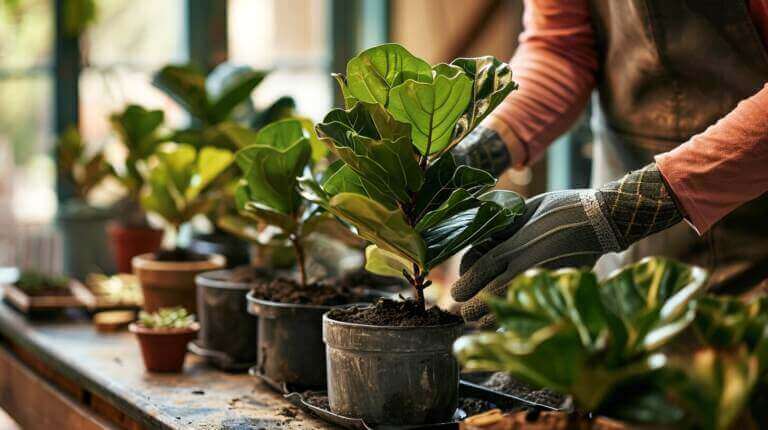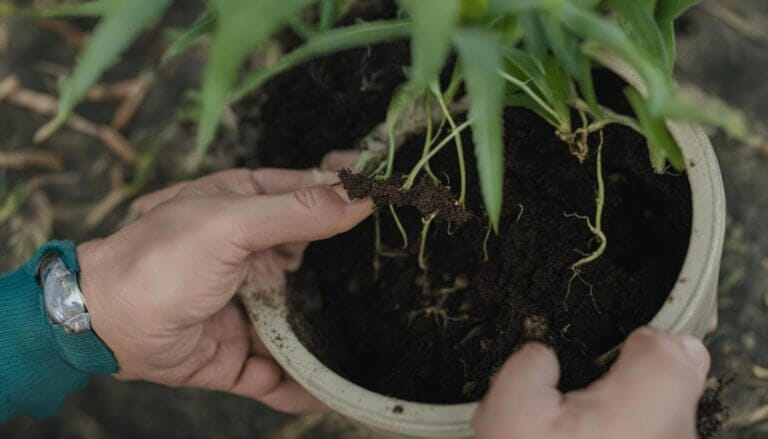Welcome to a beginner’s guide to growing and caring for lucky bamboo plants! Lucky bamboo is a popular indoor bamboo plant known for its resilience, easy care, and adaptability. In this guide, you will learn all about lucky bamboo care, care for lucky bamboo, lucky bamboo plant care, and tips for nurturing an indoor bamboo plant. By following these steps, you will be able to enjoy a healthy and thriving lucky bamboo plant at home.
Key Takeaways
- Lucky bamboo (Dracaena sanderiana) is an easy-to-care indoor plant, perfect for beginners.
- Understanding lucky bamboo’s origin and cultural significance enhances its appreciation.
- It is vital to provide indirect sunlight and consistent temperature for your lucky bamboo.
- Planting options include using soil or water as a medium, depending on personal preference.
- Master lucky bamboo care by following proper watering techniques, fertilizing, and pruning tips.
- Easily propagate your lucky bamboo through cuttings to grow new plants.
- Creative shaping and designing with lucky bamboo can bring unique expressions and beauty to your space.
Understanding Lucky Bamboo: Origin, Species, and Cultural Significance
Lucky bamboo, also known as Dracaena sanderiana, is a popular and versatile house plant admired for its distinct appearance and cultural significance. Read on to learn more about the unique identity, tropical ancestry, and symbolism of this fascinating plant.
The Unique Identity of Lucky Bamboo
Despite its common name, lucky bamboo is not actually a true bamboo plant. It belongs to the Asparagaceae family and is more closely related to agave and yucca. Dracaena sanderiana, with its characteristic striped stems and vibrant green foliage, is often referred to as Chinese water bamboo due to its ability to grow in water as well as soil.
Lucky Bamboo’s Tropical Ancestry
Native to the tropical rainforests of Africa, lucky bamboo thrives under the dense canopy where it is adapted to low light conditions. This makes it an ideal house plant, as it can flourish in indirect sunlight and a range of indoor environments. There are several varieties of lucky bamboo that showcase different characteristics, such as the vibrant leaves of the ‘Gold’ or striped stems of the ‘Victory’ variety.
Feng Shui and Symbolism: More Than Just a Plant
Lucky bamboo holds a special place in Chinese culture due to its symbolic significance in the practice of Feng Shui. The number of stalks in a lucky bamboo arrangement is believed to affect the energy of the environment it is placed in, with each number representing a different aspect of life:
- Two stalks: Love and marriage
- Three stalks: Happiness, wealth, and long life
- Five stalks: Emotional, mental, physical, and spiritual well-being, as well as overall good fortune
- Eight stalks: Wealth and abundance
By paying attention to these symbolic meanings, lucky bamboo becomes more than just a house plant: it serves as a meaningful addition to the home or office, promoting harmony, balance, and prosperity.
Choosing the Right Environment for Lucky Bamboo
Providing the right growing conditions for your lucky bamboo plant ensures its healthy growth and longevity. One of the key aspects to consider for indoor bamboo plants is where to place the plant. Both indirect sunlight and stable temperature conditions are essential for the health of indoor bamboo plants. In this section, we will discuss how indoor bamboo plants require specific care and how to grow your lucky bamboo successfully.
Selecting the Ideal Spot: Light and Temperature Conditions
Lucky bamboo thrives in moderate, indirect sunlight. Place the plant near windows or other areas that receive bright, filtered light. Avoid exposing the plant to direct sunlight as it can cause the leaves to scorch and turn brown. The table below summarizes ideal light and temperature conditions for lucky bamboo:
| Aspect | Ideal Conditions |
|---|---|
| Light | Indirect sunlight, bright but filtered light |
| Temperature | 65-90°F (18-32°C) |
| Avoid | Direct sunlight, temperature fluctuations |
Maintain a consistent temperature for your lucky bamboo by keeping it away from heating or cooling vents, radiators, or drafty windows. Rapid temperature fluctuations can stress the plant and cause yellowing leaves or stunted growth.
Battling Direct Sunlight and Maintaining a Consistent Climate
To protect your lucky bamboo from the harmful effects of direct sunlight, use sheer curtains or move the plant slightly away from the window. Diffusing the sunlight helps prevent leaf scorch and ensures a healthier plant.
Consistency is key when it comes to maintaining the ideal climate for your lucky bamboo. Avoid placing the plant in areas where it could be exposed to temperature extremes, such as next to a drafty door or a stove. Instead, opt for locations that provide a stable, moderate environment.
“Lucky bamboo prefers consistent, indirect sunlight and stable temperatures for healthy growth. Be mindful of where you place your plant to ensure a thriving, long-lasting lucky bamboo.”
In conclusion, choosing the right environment for your lucky bamboo is vital for its growth and overall health. By following these suggestions, you can create the ideal conditions for your indoor bamboo plant, ensuring its success as a low-maintenance, easy-care addition to your home.
Planting Lucky Bamboo: Soil Versus Water
The versatility of lucky bamboo extends to its planting options, allowing it to thrive in both soil and water. Whether setting roots in a moist soil blend or subsisting in standing water, this resilient plant adapts to its environment.
Planting Lucky Bamboo in Soil
When planting lucky bamboo in soil, ensure that the soil medium remains lightly moist and well-drained. Use a high-quality potting mix with excellent drainage to prevent root rot. Lucky bamboo prefers a well-aerated substrate with organic components, such as peat-based soil mixtures, which encourage healthy root development.
Pro Tip: Opt for a soil mix that is rich in nutrients and retains moisture without becoming overly soggy, to provide the best environment for your lucky bamboo.
Planting Lucky Bamboo in Water
If you choose to grow lucky bamboo in water, it is important to provide regular, clean, dechlorinated or distilled water. Ensure that the water covers the roots adequately, and change the water every week to avoid toxins building up in the container, which could harm your plant.
| Planting Medium | Advantages | Disadvantages |
|---|---|---|
| Soil | Provides nutrients, allows for better aeration and moisture retention | Requires periodic watering, potential for overwatering and root rot |
| Water | Easy to maintain, faster root development, visually appealing | Requires frequent water changes, higher risk of algae growth |
Ultimately, the choice between planting lucky bamboo in soil or water depends on your personal preferences and the level of commitment you have for lucky bamboo care. With proper care and regular maintenance, your lucky bamboo can thrive in either environment, rewarding you with its lush, vibrant green foliage year-round.
Mastering Lucky Bamboo Care
Proper care for your lucky bamboo is essential in maintaining its health and growth. Incorporating the right watering techniques, fertilization, and pruning methods will optimize the plant’s potential. Let’s explore some proven lucky bamboo care tips to help you create a thriving plant.
https://www.youtube.com/watch?v=j5bu1DR4DUg
Watering Techniques: Quality and Frequency Matter
One of the most crucial aspects of caring for lucky bamboo plants is providing them with the right amount of water and maintaining water quality. Follow these guidelines to ensure optimal hydration:
- Check the water level often, ensuring it is enough to cover the roots.
- Change the water every one to two weeks, or immediately if it appears murky or smells foul.
- Utilize filtered, distilled, or dechlorinated water to avoid harmful chemicals.
- If growing in soil, keep it lightly moist, but not soggy. Overwatering can lead to root rot.
Fertilizing Your Lucky Bamboo: Less Is More
Unlike many other plants, lucky bamboo doesn’t require frequent fertilizing. In fact, too much fertilizer may be harmful. Here’s a handy care guide for proper fertilization:
- Fertilize once every three to four months with a water-soluble plant food diluted to one-tenth of the recommended strength.
- If growing in water, apply the diluted fertilizer after changing the water, pouring it directly into the container.
- For lucky bamboo planted in soil, dissolve the fertilizer in water and apply it while watering the plant.
Managing Growth: Pruning and Shaping Tips
To manage your lucky bamboo’s growth and maintain its shape, regular pruning is essential. Here are some suggestions to keep your plant looking neat and elegant:
- Trim any yellow or brown leaves with a clean pair of pruning scissors.
- To promote branching, cut the main stalk at a 45-degree angle just above a node.
- Remove offshoots growing from the stalk to maintain the desired appearance.
- To shape the plant, gently twist the stalks or use wire to secure them in the desired position. Rotate the plant to encourage even growth.
By mastering these lucky bamboo care techniques, you’ll be well on your way to a flourishing and visually appealing plant. Keep these tips in mind, and your lucky bamboo will thrive for years to come.
Propagating Your Lucky Bamboo
Propagating your lucky bamboo is an easy process, allowing you to grow new plants from your existing one. Not only does propagation save money, but it also creates an opportunity to share the good fortune with friends and family. In this section, we will guide you through the steps on how to propagate lucky bamboo and grow new, healthy plants.
- A healthy lucky bamboo plant with a few offshoots
- Sharp, clean pruning shears or a knife
- A small glass or jar filled with clean water, preferably distilled or dechlorinated
To propagate lucky bamboo successfully, follow these steps:
- Select an offshoot from the parent plant that is healthy, has some leaves, and is approximately 4 to 6 inches in length
- Using your clean pruning shears or knife, carefully cut the offshoot just below a node
- Place the cut end of the stalk directly into the glass of water, ensuring that the node is immersed, but the leaves and upper part of the stalk remain above water
- Place the glass with the newly cut stalk near a window with indirect sunlight, preferably at room temperature
- Monitor the water level and change it every week, or if it starts to look cloudy
- Wait for roots to grow, which should take about 2 to 4 weeks
Once your new lucky bamboo has established a robust root system, you can either continue growing it in water or transfer it to a pot with well-draining soil. To continue growing in water, simply place the propagated offshoot in a decorative container filled with clean water, repeating the steps above. To grow in soil, follow these steps:
- Select a pot with drainage holes and a saucer to catch excess water
- Fill the pot with a well-draining, moist soil mix, ideally a mix of peat and perlite or sand
- Make a hole in the center of the soil, deep enough to accommodate the roots without bending or damaging them
- Place the offshoot’s roots in the hole and cover them with soil, ensuring the soil is firm around the stalk, holding it upright
- Water the soil until it is evenly moist, but not soggy
- Provide the same care as you would for the parent plant: indirect sunlight, periodic watering, and occasional fertilization
As you can see, propagating lucky bamboo is a straightforward process, requiring minimal effort and supplies. With patience and care, you can easily grow new lucky bamboo plants from a single stalk. Enjoy your new plants, and may they continue to bring you good fortune and prosperity.
Common Lucky Bamboo Issues and Troubleshooting
Like any other plant, lucky bamboo may face problems despite proper care and attention. In this section, we’ll discuss some common lucky bamboo issues, such as yellow leaves and leaf tips turning brown, as well as offer guidance for preventing pests and disease, thus maintaining a healthy bamboo plant.
Tackling Yellow Leaves and Other Common Ailments
One of the most common issues affecting lucky bamboo is yellow leaves. This can be attributed to various factors such as improper watering, insufficient light, or poor water quality. Here are some lucky bamboo growing tips to tackle yellow leaves:
- Ensure your plant is placed in indirect sunlight with the right temperature.
- Use filtered, dechlorinated, or distilled water to avoid toxins and chemicals.
- Examine the soil or water to ensure it’s not overly saturated or stale.
- Prune any dying leaves to encourage new, healthy growth.
Another common issue is lucky bamboo leaf tips turning brown, which are usually caused by low humidity or excess minerals in the water. To address this, you can mist the plant with distilled water or use a pebble tray to increase humidity. For brown tips due to mineral buildup, switch to distilled or filtered water.
“Preventing common ailments in lucky bamboo starts with good plant care practices. Keep an eye on your plant’s environment and water quality to ensure healthy growth.”
Preventing Pests and Disease for a Healthy Bamboo
While lucky bamboo is relatively resistant to pests and diseases, some issues might still arise. Here are some tips to keep your plant healthy and pest-free:
- Keep the leaves and growing area clean, removing any debris or dead leaves.
- Regularly inspect your plant for signs of pests such as spider mites, mealybugs, and scale insects. If you notice any, use a cotton swab dipped in alcohol to remove them, then spray the plant with insecticidal soap or neem oil to prevent further infestations.
- Ensure proper ventilation around your lucky bamboo, as stagnant air can encourage the growth of mold and other diseases.
- Separate any affected plants from healthy ones to prevent the spread of pests or diseases.
By tackling yellow leaves, monitoring water quality, and preventing pests and disease, you can ensure the long-term health of your lucky bamboo plants. All it takes is a bit of attention and proactive care to keep your indoor greenery thriving.
Creative Aspects: Shaping and Designing with Lucky Bamboo
Lucky bamboo provides a unique opportunity for creative expression through its flexibility and adaptability to various shapes and designs. Growing and bending lucky bamboo into different forms can transform a simple stalk into eye-catching pieces of living art, making it both a fascinating hobby and an impressive decorative element for your living space.
To begin shaping lucky bamboo, position your plant near a light source that promotes growth in the desired direction. As the stalks reach towards the light, you can guide them into spirals, weaves, and other intricate lucky bamboo designs. To maintain the desired shape, and to ensure balanced growth, rotate the plant regularly with care.
Another effective method for controlling the growth patterns of lucky bamboo is by using shaping tools and techniques. This way, you can train your bamboo to grow into all kinds of interesting patterns and formations. Here are a few popular methods to consider:
- Using wires: Flexible wires can be wrapped around the plant to help guide it into spirals or curves. As the bamboo grows, you can gently adjust the wire to maintain the desired shape.
- Tying: Tying your lucky bamboo stalks together with soft twine or cloth strips can encourage them to grow in the direction of the tie. Once the desired shape is achieved, remove the ties gently to avoid damaging the stems.
- Grow cabinets: A specially designed grow cabinet can safely enclose your lucky bamboo while directing its growth in specific directions. This method often results in more intricate designs and patterns, as the plant is forced to grow within the constraints of the structure.
When designing with lucky bamboo, you can create stunning displays by incorporating multiple stalks, different shapes, and various braiding techniques. Bamboo designs can be further enhanced by placing your creations in a visually impressive container, such as a clear glass vase filled with colorful pebbles or marbles. Keep in mind that the key to achieving beautiful, healthy bamboo designs is maintaining proper care and attention for the plant.
“Nature is the greatest artist, and lucky bamboo allows you to participate in that artistry, turning living plants into intricate designs that make a statement in your space.”
Experiment with different creative aspects of lucky bamboo to see what works best for you, and remember to share your creations with friends, family, or online communities. Not only will you enhance your living space with these living pieces of art, but you’ll also be engaging with the rich history and culture that surrounds this fascinating plant.
Purchasing and Gifting Lucky Bamboo
Whether you’re looking to buy lucky bamboo for yourself or as a gift, there’s no doubt that it makes for an attractive and thoughtful present. When considering purchasing and gifting lucky bamboo, it’s essential to select an arrangement that aligns with the intended symbolism, be it for love, wealth, or health. As the number of stalks represents different meanings, choosing the right arrangement becomes a reflection of your intentions.
Various lucky bamboo varieties, such as ‘Victory’ with striped stems or ‘Gold’ for bright leaves, can be easily found in online nurseries or local plant outlets. With the plant’s adaptability and low maintenance, lucky bamboo offers an excellent option for anyone looking to bring some greenery and good fortune into their home or as a gift to a friend or family member.
When gifting lucky bamboo, researching the recipient’s preferences to ensure the arrangement’s relevance to their life and interests will amplify the gesture’s thoughtfulness. Whether purchasing it for your own home or as a present, lucky bamboo’s symbolism and its easy plant care give it a unique and meaningful position in the world of indoor plants.
FAQ
What is the best environment for lucky bamboo?
Lucky bamboo prefers indirect sunlight and is well-suited for indoor spaces with consistent temperatures. Direct sunlight should be avoided, as it can scorch the leaves.
How often should I water my lucky bamboo?
For lucky bamboo grown in water, change the water every week with fresh, dechlorinated or distilled water. If it’s grown in soil, keep the soil lightly moist and water when the top inch becomes dry.
Can I grow lucky bamboo in water or soil?
Lucky bamboo can grow both in water and soil. Choose whichever medium you prefer, but ensure that the plant has the necessary nutrients and proper care in either environment.
How do I propagate my lucky bamboo?
Clip an offshoot from the parent plant just below a node and place it in water to encourage rooting. Once established, the offshoot can either be transferred to compost or remain in water for continued growth.
Can I shape and design my lucky bamboo?
Yes, you can train lucky bamboo into various shapes and designs by carefully manipulating the direction of its growth towards a light source and rotating the plant as needed.
How do I choose the right lucky bamboo as a gift?
When gifting lucky bamboo, select a plant arrangement that corresponds to the intended symbolism, such as love, wealth, or health. The number of stalks and the specific variety of lucky bamboo play important roles in conveying your intentions.
How do I identify and address common issues with my lucky bamboo?
Common issues include yellow leaves, pests, and diseases. To maintain a healthy plant, check for signs of problems regularly and make adjustments to the care routine as needed. For example, yellow leaves may indicate poor water quality, so try using distilled water or, if growing in soil, maintain proper moisture levels.







